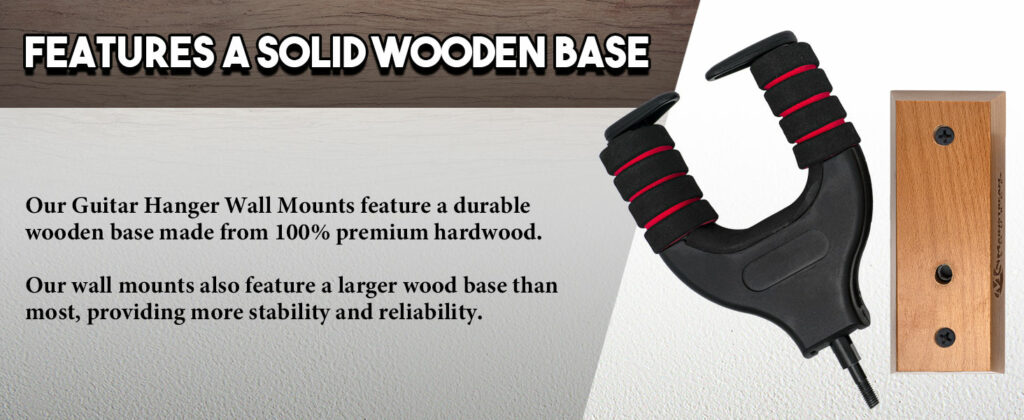Guitar Wall Cradles by Mainstream Source
Mainstream Source Guitar Wall Cradles
Mainstream Source Guitar Wall Cradles are an excellent choice to hang your valuable guitars. With a slightly larger solid wood wall plate than other brands, when installed correctly they easily and safely hold even the heaviest of guitars.

Our large pressure-release Mainstream Source Guitar Wall Cradles lock your guitar safely in place while allowing you to simply raise it up to unlock it and pull it out, for an extra layer of protection. All of our guitar cradles are also available in bundles of 2, 3 and 4… for additional savings.
Our standard Mainstream Source Guitar Wall Cradles cradle your guitar comfortably, resting it on strong metal arms coated in soft rubber with rubber stops, making it easy to grab your guitar quickly and go to work.

WHY IS IT BETTER TO HANG YOUR GUITAR ON THE WALL?
More than likely, the safest place for your guitar is in a case, unless the place where you store your guitar is subject to extreme fluctuations in temperature. By the same token, leaving your guitar in the direct sunlight can warp the bridge… and in rare circumstances, extreme heat can also crack the soundboard. Probably the LEAST safe place to store your guitar is on a floor stand. Anyone, including your dog, or other musicians onstage, can trip on the stand and send your guitar flying, cracking the headstock or scratching your guitar. When you place your guitar on a padded hanger on the wall, it is safe, out of the way of traffic and easy to grab. And, the downward pull of the guitar’s weight actually takes some stress off of the pull of the strings in the other direction.

Our Mainstream Source Guitar Wall Cradles are softly padded and formed in a way that should never affect your tuning mechanism or pegs, and because the padding is just soft enough, they will not damage the finish on your guitar in any way.
In general, no matter how you store your guitar, it is important to check the humidity in the room where your guitars are stored. Hygrometers are inexpensive, and you may want to use a humidifier, especially when you run your heat during the cold winter months. The main thing is to play and pamper your guitar as much as possible. The more attention it gets, the longer it should last!

HOW CAN I TAKE CARE OF MY GUITAR?
Believe it or not, the most important thing you can do over time is to simply wash your hands before you play your guitar! Oils and dirt on your hands will affect the strings, allowing them to deteriorate faster and become harder to play. If you wipe down your fret board after each use, this will also help to keep oil and sediment on your strings to a minimum.
Having said that, the next best thing to do is to change your strings frequently. As a general rule, if you play your guitar for a good amount of time each day you should change your strings every month. Of course, the type of music you play can change that formula as well as the quality of the strings you are using. It’s a great feeling to hear how great your guitar sounds with new strings!
Most professional guitarists take their guitars to a technician regularly, just as one might do with your car; it’s preventative maintenance. A good technician will fine-tune your guitar’s alignment, check your frets and repair anything that’s loose, deeply clean and polish your guitar, and they’ll change your strings. The main thing is to play and enjoy it regularly.

ANATOMY OF THE GUITAR
Your guitar consists of a headstock, neck and body.
The headstock contains the tuning pegs, allowing you to adjust the tension of the strings and effectively to tune the guitar. The strings are wound around the tuning pegs and settled into the nut… a metal bar, which sits between the headstock and the neck of the guitar.
The neck of the guitar contains the frets (metal strips embedded on the fret board) and fret wire, allowing the player to change the tone of each string by placing their finger between the frets.
The body of the guitar contains the sound hole (on acoustic and acoustic/electric guitars) allowing the guitar to produce a louder sound… and the table or top plate of the body, which holds the saddle.
The saddle is where the strings originate on the guitar. This plate on the far end of the table is extremely important, allowing you to adjust the action, or the distance between the fret board and the strings, allowing you to play the guitar more effortlessly. On electric guitars, the saddle is where you place metal pick-ups, picking up the sound of the strings and allowing the guitar to be amplified by an outside source. Different pick-ups produce different qualities of sound. Some electric guitars also contain a whammy bar, a metal bar placed on the body allowing the guitarist to ‘bend’ the strings by the use of the bar, creating a unique effect.

THE HISTORY OF THE GUITAR
It is believed that the guitar was modeled upon the lute, a stringed instrument dating back to around 3100 B.C., in the Middle East. The lute was generally a plucked or bowed instrument.
No one is actually sure where the first guitar originated, but it is assumed that the first guitars came from Spain. During medieval times, the Guitarra Latina was a stringed instrument and the precursor to the modern guitar. It had a deeper body and a narrower neck than today’s guitars.
Early guitars from the 16th century generally had 4 strings, tuned in C-F-A-D. The belly of the guitar was the soundboard with a circular hole, created to amplify the sound of the strings through the deep-bodied belly. A “bridge” was built on to the far end of the belly, guiding the strings to the pegbox on the neck. The pegbox on the end of the neck was modeled after the violin, anchoring the strings on the end.
Modern guitars are quite similar to the early guitars in shape, but the guitar has evolved in a hundred different ways since the early guitar was born. Unless you’re playing a modified guitar, odds are yours will have 6 strings, tuned in E -A – D – G – B – E.

No matter whether you use a lovely, classical nylon-stringed acoustic guitar or you are a metal electric rock-god, you can feel great about proudly hanging your guitar on the wall with our Mainstream Source Guitar Wall Cradles!









